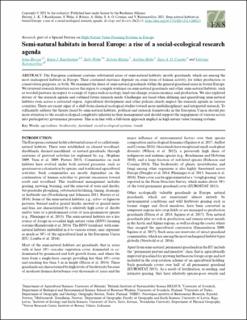Semi-natural habitats in boreal europe: A rise of a social-ecological research agenda
| dc.contributor.author | Herzon, Irina | |
| dc.contributor.author | Raatikainen, Kaisa J. | |
| dc.contributor.author | Wehn, Sølvi | |
| dc.contributor.author | Rūsiņa, Solvita | |
| dc.contributor.author | Helm, Aveliina | |
| dc.contributor.author | Cousins, Sara A. O. | |
| dc.contributor.author | Rašomavičius, Valerijus | |
| dc.date.accessioned | 2022-03-02T14:31:00Z | |
| dc.date.available | 2022-03-02T14:31:00Z | |
| dc.date.created | 2022-02-09T15:55:43Z | |
| dc.date.issued | 2021 | |
| dc.identifier.citation | Ecology & Society. 2021, 26 (2), . | en_US |
| dc.identifier.issn | 1708-3087 | |
| dc.identifier.uri | https://hdl.handle.net/11250/2982603 | |
| dc.description.abstract | The European continent contains substantial areas of semi-natural habitats, mostly grasslands, which are among the most endangered habitats in Europe. Their continued existence depends on some form of human activity, for either production or conservation purposes, or both. We examined the share of semi-natural grasslands within the general grassland areas in boreal Europe. We reviewed research literature across the region to compile evidence on semi-natural grasslands and other semi-natural habitats, such as wooded pastures, in respect to a range of topics such as ecology, land-use change, socioeconomics, and production. We also explored drivers of the research agenda and outlined future research needs. Challenges are faced when defining and quantifying semi-natural habitats even across a restricted region. Agricultural development and other policies clearly impact the research agenda in various countries. There are recent signs of a shift from classical ecological studies toward more multidisciplinary and integrated research. To sufficiently address the threats faced by semi-natural habitats, political and research frameworks in the European Union should pay more attention to the social-ecological complexity inherent in their management and should support the engagement of various actors into participatory governance processes. This is in line with a full-farm approach implicit in high nature value farming systems. | en_US |
| dc.language.iso | eng | en_US |
| dc.rights | Navngivelse-Ikkekommersiell 4.0 Internasjonal | * |
| dc.rights.uri | http://creativecommons.org/licenses/by-nc/4.0/deed.no | * |
| dc.title | Semi-natural habitats in boreal europe: A rise of a social-ecological research agenda | en_US |
| dc.type | Peer reviewed | en_US |
| dc.type | Journal article | en_US |
| dc.description.version | publishedVersion | en_US |
| dc.rights.holder | © 2021 by the author(s) | en_US |
| dc.source.pagenumber | 15 | en_US |
| dc.source.volume | 26 | en_US |
| dc.source.journal | Ecology & Society | en_US |
| dc.source.issue | 2 | en_US |
| dc.identifier.doi | 10.5751/ES-12313-260213 | |
| dc.identifier.cristin | 1999643 | |
| dc.relation.project | EC/H2020/696391 | en_US |
| dc.source.articlenumber | 13 | en_US |
| cristin.ispublished | true | |
| cristin.fulltext | original | |
| cristin.qualitycode | 1 |
Tilhørende fil(er)
Denne innførselen finnes i følgende samling(er)
-
Divisjon for matproduksjon og samfunn [999]
Publikasjoner knyttet til ansatte ved Divisjon for matproduksjon og samfunn -
Publikasjoner fra CRIStin - NIBIO [4517]
-
Vitenskapelige artikler [1416]

